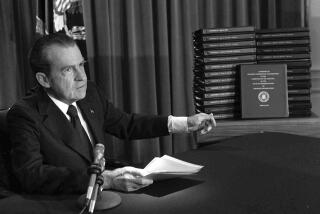‘After the Music Stopped’ looks back at the fiscal collapse
After the Music Stopped
The Financial Crisis, the Response and the Work Ahead
Alan Blinder
Penguin Press: 496 pp., $29.95
“Obamanomics was an incoherent blur to most citizens — and a not very successful blur, at that,” writes Alan Blinder in “After the Music Stopped: The Financial Crisis, the Response and the Work Ahead,” a thoughtful attempt by one of the nation’s top economists to puzzle through what happened in 2007-09 with the benefit of some perspective.”The president and the country would pay a steep price for his failure to communicate, to educate, and to convince.”
It’s a failure Blinder tries to remedy in a detail-packed book that attempts to explain to the average American what happened and why. After all, even those who pay moderate attention to the news may run into trouble when asked, at a dinner party, to explain what caused the financial crisis and why the government responded the way it did.
It seems simple enough: Banks got people to buy mortgages they couldn’t afford, lost money when homeowners defaulted, sending the financial institutions that invested in those mortgages tumbling. They didn’t recover until the government lent them money.
But when pressed to answer questions – like, why did the government save Bear Stearns and not Lehman Bros.? Why haven’t government programs been able to save troubled homeowners? — it soon becomes evident: Your best move is to hide in the bathroom until the topic turns to something a little easier to understand, like celebrity news.
That’s because the causes and responses to the fiscal crisis are mind-achingly complicated, as Blinder shows us. He’s more than qualified as a guide through the maze: a professor of economics and public affairs at Princeton, Blinder writes a monthly op-ed for the Wall Street Journal and has done stints as vice chairman on the Federal Reserve’s Board of Governors and as a member of President Clinton’s Council of Economic Advisers.
It’s not just that home prices were inflated, Blinder explains; bond prices were too. Banks were overly leveraged, putting too many of their assets into risky investments. They weren’t closely regulated, nor were securities and derivatives, which Blinder describes as a “wild and woolly world ... into which regulators were not allowed to set foot.” Financial companies shopped around to find the ratings agency that would give them the best credit ratings, so they could appear more stable than they were. Compensation schemes motivated bankers to take big risks, knowing they would be richly rewarded for making money and not punished much for losing it.
When the government stepped in, it did so with a patchwork of policy prescriptions that the public could barely understand. Treasury Secretary Henry M. Paulson’s original request to Congress for $700 billion for the Troubled Asset Relief Program was only three pages long and was attacked for its vague wording and its provision that the bill could not be reviewed by the courts.
The public never understood TARP, Blinder says, seeing it instead as a way to give money to greedy banks. A 2012 Pew poll showed that just 39% of Americans thought TARP was the right thing to do and that only 15% of Americans understood that banks ended up paying back most of the money loaned to them.
Overall, Blinder argues, the government failed to explain to the public why the nation had gotten itself into a financial crisis and what actions it was taking to get out of it.
But in “After the Music Stopped,” Blinder runs into the same problem the government faced when trying to explain what was going on in the panicky days of 2008: the financial system has become so complicated and technical that it takes a whole lot of work to understand exactly how we got into this mess. This is no Malcolm Gladwell-esque pop summary of the recession of 2007-09 – it may be no surprise to readers that Blinder is also known for co-writing his popular economics textbook “Economics: Principles and Policy.”
Take, for example, this explanation about the difficulties the Federal Reserve faces in once again raising interest rates, after lowering them to all but zero during the financial crisis: “By comparing the nominal interest rate on regular 10-year Treasury notes with the real interest rate on 10-year TIPS (Treasury Inflation-Protected Securities), one can extract a market-based estimate of expected inflation over a ten year horizon, as explained in the accompanying box,” Blinder writes.
It doesn’t matter how much you want to understand the financial crisis — sentences like that will make even the most stalwart reader curl up into a ball and long for an US Weekly.
Of course, the simpler parts of Blinder’s book are useful for anyone who wants to sound reasonably intelligent about the crisis. He gives a blow-by-blow of the government’s decision to save Bear Stearns and then its frantic attempts to find a suitor for Lehman Bros., which ultimately failed.
Some of the personalities that led financial institutions into this mess come into focus here, including Stan O’Neal of Merrill Lynch, who decided the company didn’t have a big enough footprint in the subprime mortgage market, and hired an expert to remedy that. Blinder points out that Lee Farkas, the head of a small mortgage company, was the highest-ranking financial official to be convicted for offenses related to the financial crisis, illuminating how unbalanced a system is where none of the perpetrators have gotten into much trouble.
And his prescriptions for going forward, which include banning self-regulation by banks and fixing compensation systems that reward risky behavior, are spot-on.
But those hoping to prepare for their next dinner party while sipping a glass of wine and reading “After the Music Stopped” might be overwhelmed. By the very nature of the complicated maneuverings that got us into the financial mess, Blinder can’t follow one of his own concluding maxims, borrowed from his Clinton days: Keep it simple, stupid.
More to Read
Sign up for our Book Club newsletter
Get the latest news, events and more from the Los Angeles Times Book Club, and help us get L.A. reading and talking.
You may occasionally receive promotional content from the Los Angeles Times.










